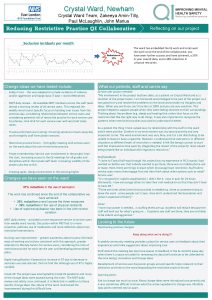Crystal Ward Newham Crystal Ward Team Zakeeya AminTilly

- Slides: 1

Crystal Ward, Newham Crystal Ward Team, Zakeeya Amin-Tilly, Paul Mc. Laughlin, John Marius Reflecting on our project Seclusion incidents per month Reduction of 37% The ward has embedded the Qi work and continued the work since the end of the collaborative, you have seen further success and have achieved, a 35% in your overall data, and a 38% reduction in physical restraints. Change ideas we have tested include: What our patients, staff and carers say - Safety Cross – this was adapted to include incidence of violence and/or aggression and happy days (7 days = ward celebration). - MDT daily review – All available MDT members across the staff team attend a morning review of all service users. This replaced the weekly ward round. Specific focus on handing over issues from the previous day, considering relationships between service users and considering potential risk of restrictive practice for each service user. No phones, time limit for each service user and very brief notes taken. Service user project member: “My involvement in the project had two sides, as a patient on Crystal Ward and as a member of the project team. I am honoured and privileged to be part of the project as it was good to try and resolve the problems on the ward and provide my thoughts and ideas. When you are ill you can’t function at 100% and you are very sensitive. This project helped to support people when they were feeling sensitive to their surroundings. Thinking about the problem (e. g. sleep) and treating that rather than focus on the restriction felt like the right way to do things. It was also important to recognise the patterns when restrictive practices was used to understand it better. - Trauma-informed care training: 3 training sessions in team away day and fortnightly staff formulation sessions. - Restrictive practice forum – fortnightly meeting with service users on the ward about the use of restrictive practice. - Project membership: Service user involvement in the project from the start, increasing access to the QI meetings for all grades and disciplines within the Crystal staff team. Increasing visibility of the project also key to this. - Creating quiet, sleepy environment in the evening/nights Changes we have seen on the ward 37% reduction in the use of seclusion The work has continued since the end of the collaborative we have achieved: • 35% reduction overall across the three measures • 38% reduction in the use of physical restraints • Use of rapid tranquilisation has been in line with normal variation MDT daily review – provided a more responsive service to service users than weekly ward rounds. Discussion within MDT led to a more proactive, judicious use of medication and more reflection about nonrestrictive interventions. Nursing care improvement – greater awareness about trauma informed ways of working and actions consistent with this approach, greater attention to lifestyle factors for service users, considering the risks of restrictive practice for each service user and developing personalised plans. Rapid tranquilisation: Expected an increase in RT due to decrease in seclusion use and restraint. Did not find this although use of RT is highly variable. Covid-19: The project was interrupted by Covid-19 pandemic and many of the change ideas were paused during this time. The MDT daily review and safety cross continued. It is likely that in addition to these specific change ideas the culture of the team maintained the improvement during this difficult time. As a patient the thing I most valued was my relationship with the staff on the ward which were positive. Comfort in my environment was my second priority and very important to me. The ward environment was very fiery, and it is a bit distributing to be unable to leave to have a cigarette. However, I understand that everyone is in different situations so different levels of restriction is needed. It felt like being in prison to start with but improved as time went by. [Regarding the impact of the project] I most valued being treated like an individual with regards to restriction. ” Staff feedback: “I came to Crystal half-way through this project but my experience in PICU wards I had worked on before was that nobody wanted to go there, there was no mobile phone use or leave. Here, there are things in place which encourage least restriction. Staff talk to service users more; they engage first and then think about other options such as meds” Service user: “It’s not good [re: rapid tranquilisation]. I didn’t like it. I was in pain for 24 hours afterwards, I now encourage others to take their oral medication so that they don’t have to have IM. ” “There are times when [restrictive practice] is needed e. g. there as someone trying to leave the ward. . some people can’t cope…they don’t understand the boundaries and [what is expected of them]. ” Carer: “more man power is needed… is staffing levels are up, incidents will reduce because the staff will look out for what’s going on…. If patients see staff are there, they are not likely to be violent and aggressive. ” Looking to the future Maintaining positive changes: Keep doing what we’re doing!!! A weekly community meeting provides a place for service users to feedback about their experiences and make suggestions about improving care. Staff attend this meeting but also have spaces to feedback in the bi-monthly away day when there is a space set aside for reviewing the data (will continue to be collected for the time being), innovation and change ideas. Development of service user discussion groups around specific topics relevant to their admission and time on the ward (expanding the restrictive practice forum) Learning point: Not to change too much at once: Many change ideas were introduced concurrently and it was sometimes difficult to know what the active ingredient to change was. Monthly data points seemed too far apart.

